
Top 25 Rankings 1901-1935
1927 National Championship
Home
1927
College Football Top 25
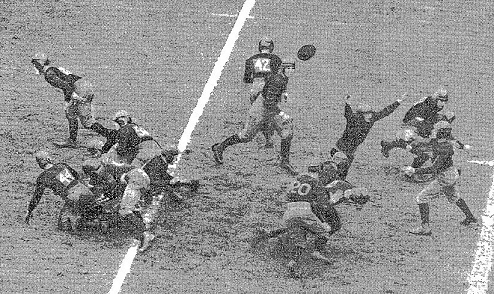
Pictured
above is Yale going to the air to rally in the 4th quarter for a 14-6
win over Princeton, who was coming into the game 6-0 and dreaming of a
mythical national championship (MNC). Instead, Yale claimed
an MNC with a 7-1 finish, though they are just one of 5 schools that
were selected as an MNC for 1927 by one organization or another.
The contenders for the 1927 MNC were Yale, 9-1 Georgia, 7-0-1
Illinois, 8-0-1 Texas A&M, and 10-0 Centenary, and I summarized all
of these teams and compared them in detail in my 1927 national championship article.
As I concluded there, only 7-1 Yale and 8-0-1 Texas A&M are viable
choices for #1, and an AP poll would certainly have rated Yale higher,
and probably #1, so Yale will take the top slot of this hypothetical
1927 AP poll top 25. Texas A&M got very little attention outside
the Southwest this season, and as such I believe a 1927 AP poll would
have ranked them about #15. And that's my biggest problem with a
hypothetical AP poll for 1927.
Texas A&M and the Southwest
I covered these teams and this issue in more detail in my 1927 national championship article, but in summary:
The
Southwest had an unusually strong season. 8-0-1 Texas A&M, 10-0
Centenary, 7-2 Southern Methodist, 6-2-1 Texas, 8-1 Arkansas, and 4-3-2
Texas Christian were all good, and this group of teams only lost to or
tied each other. Southern Methodist beat Missouri Valley champion 7-2
Missouri 32-9, and Texas beat 8-1-2 Vanderbilt 13-6. Since Missouri
beat Iowa State, who tied 7-0-1 Illinois, and Vanderbilt tied 8-1-1
Georgia Tech, who beat 9-1 Georgia, who beat 7-1 Yale, Texas A&M
and Centenary sit atop victory chains above every other team in the
nation, whereas the best teams outside the Southwest sit on no victory
chains atop these 6 Southwest teams, given that no outside team
defeated or tied any of them.
It
would be logically viable to rate all 6 of these teams in or very near
the top 10, which would make Texas A&M a certain #1 team, and
that's how I would lean for my own top 25. However, the hypothetical AP
voters of 1927 have some case for not taking the Southwest quite that seriously. The 2
intersectional victories over Missouri and Vanderbilt were the only
ones the region earned that really mattered, both were home games, and
it is all too easy for such a small sample to be misleading. After all,
the Southwest had not performed very strongly against outside
competition (except against the Southeast) in prior years, and the
Southwest would not perform well in the immediately succeeding years
either.
Centenary, Arkansas, and Texas all struggled to beat 2-7
Baylor, who lost to Southwestern (Texas) and to 2-6-1 Rice. TCU was
unimpressive in a 20-13 win over Trinity (Texas), and TCU tied Texas
and Texas A&M. So there are reasons to believe that the Southwest
was not that much stronger than in prior years.
I
will therefore try to rate these Southwestern teams as lowly as possible, to reflect
the national opinion of the time, but I do disagree with it, and I
would personally rate all these teams much higher than they'll end up
below. But on the positive side, most of them will end up ranked higher
than an actual AP poll would have placed them.
#2:
Illinois vs. Army
I
think 7-0-1 Illinois and 9-1 Army would have been in a close race for
#2 in a 1927 AP poll, and though I suspect that Army would have
prevailed, it doesn't really matter, because regardless of which team
an AP poll would have preferred, Army belongs rated ahead of Illinois.
Illinois, in fact, does not belong in the top 5. Similar to Illinois' 1928 team that went 7-1, Illinois was overvalued by writers this season and built a nice-looking straight record on a weak schedule.
Illinois did have one big win, 14-0 over 6-2 Michigan (will be
rated #10), but that was their only victory over a winning major
opponent, and they were tied at home by 4-3-1 Iowa State, who would not
merit a top 50 ranking. Illinois' performance was also lackluster, as they
outscored their major opponents, weak as they were, by an average score
of just 13-4, including a 7-6 win over 4-4 Northwestern.
Army's only loss came to #1 Yale, so Illinois' tie with Iowa State gave Army a relevant record
that was effectively half a game better than that of Illinois. Army
defeated 7-1-1 Notre Dame (will be rated #3) 18-0, and they also beat
7-2 Detroit, 6-3 Marquette, and 6-3 Navy.
Army is #2.
Army was coached by Hall of Famer Biff Jones, who had played tackle on Army's 1916
MNC team. He went 30-8-2 at Army 1926-1929, and was 87-33-15 overall at
4 schools, taking Nebraska to the Rose Bowl following the 1940 season.
On the field, Army was led by consensus All American halfback Red Cagle
(Hall of Fame), and blocking for him were a pair of nonconsensus AA
tackles, Bud Sprague (HoF) and George Perry.
#3: Illinois vs. Notre Dame vs. Minnesota
7-1-1 Notre Dame
lost only to #2 Army, irrelevant when comparing them to 7-0-1 Illinois
since Illinois did not play so powerful an opponent. Notre Dame's tie
came against 6-0-2 Minnesota, a far better result than Illinois' tie
with 4-3-1 Iowa State. Notre Dame defeated 8-1-1 Georgia Tech (will be
#8) 26-7, 8-1-1 Southern Cal (will be #6) 7-6, and they also beat 7-2
Detroit and 6-3 Navy, and those accomplishments blow away
what Illinois did. So Notre Dame belongs ahead of Illinois.
6-0-2
Minnesota was tied by 3-4-1 Indiana, and Notre Dame did not take an
upset (outside their tie with Minnesota), so Notre Dame belongs rated
ahead of Minnesota as well.
Illinois won the Big 10 outright because they took their upset tie
against nonconference foe Iowa State, while Minnesota took theirs
against Indiana. However, aside from the conference race, those ties
are equally egregious results. Well, nearly equal-- Illinois took their
upset tie at home, and Minnesota took theirs on the road. Both teams
beat 6-2 Michigan, and that was the only winning major team either of
them defeated. And both teams had one close win over an unrated
opponent. So the only relevant difference between the 2 teams is
Minnesota's tie at now-#3 Notre Dame.
Now
the simplistic thought is that a tie is always bad, since it counts as
half a loss. But it is also half a win. And in this case, Minnesota's
2nd tie is the reason that they should be rated ahead of Illinois,
despite the fact that it gave them a worse straight record. Notre Dame
should definitely be rated higher than Illinois, and since the only
relevant difference between Illinois and Minnesota is the fact that
Minnesota tied Notre Dame on the road, Minnesota must logically be
rated ahead of Illinois as well. Because they tied a team that is rated
higher than Illinois.
Notre Dame #3, Minnesota #4.
Minnesota
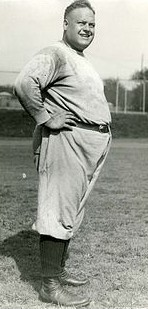
Minnesota
was one of the top football programs in the country 1901-1941, likely
second only to Michigan for that timespan. Their strongest eras were
1900-1919 under Henry Williams and 1933-1941 under Bernie Bierman, but
in this in-between time they weren't bad. This 1927 team was the best
of the in-betweeners. Clarence "Doc" Spears (pictured) was the coach.
He was a Hall of Fame guard for Dartmouth, and was 21-9-1 as coach at
his alma mater 1917-1920. Then he went 30-6-3 at West Virginia
1921-1924, and Minnesota got hold of him after that. He was 28-9-3 at
Minnesota 1925-1929. Overall, he was 148-83-14 at 7 schools and over 28
seasons.
This team was led on the field by consensus All
American fullback Herb Joesting. Joesting totaled 1850 yards rushing
for his career, and he is in the Hall of Fame. Tackle Bronko Nagurski,
a consensus AA in 1929, is in both the college and pro Hall of Fame.
Guard Harold Hanson was a nonconsensus AA this season.
#5: Illinois vs. Georgia
9-1 Georgia took
an upset loss to 8-1-1 Georgia Tech, but they made up for it by beating
#1 Yale on the road. Illinois, however, did not make up for their upset
tie to 4-3-1 Iowa State. Georgia's relevant record was therefore
effectively half a game better. And the rest of Georgia's games were
all routs, so they performed better than Illinois, and Georgia defeated
5 major winning opponents to Illinois' 1, so yeah, this is no contest.
Georgia
could be rated higher than Minnesota as well, but an AP poll would have
rated Minnesota higher, and that's viable (the 2 teams have the same
relevant record), so we'll go with that. Minnesota tied #3 Notre Dame on the road the week
after Notre Dame crushed Georgia Tech 26-7, and Georgia Tech beat
Georgia 12-0 in their finale.
Georgia #5.
#6: Illinois vs. Southern Cal
8-1-1 Southern
Cal took their loss 7-6 to #3 Notre Dame in Chicago, irrelevant when
comparing them to 7-0-1 Illinois, and in fact, if anything that score
represents a big positive for USC. Southern Cal's tie came at 8-2-1
Stanford (will be rated #11), while Illinois took their tie to an
unrated team at home. Huge advantage for USC. USC defeated 9-2
Washington 33-13 and 7-3 California 13-0, and both those teams will be
rated here, while Illinois had just the one victory over a strong team.
Nothing points to Illinois here.
As for USC vs. #5 Georgia, I'm
not sure which one an AP poll would have rated higher. It would have
been close. But since Georgia had the better straight record and better relevant record, I'm giving them the edge here.
Southern Cal #6.
#7:
Illinois vs. Texas A&M vs. Georgia Tech
I'm thinking
that a 1927 AP poll would have had 7-0-1 Illinois #3, 8-0-1 Texas
A&M around #15, and 8-1-1 Georgia Tech #11-15, yet here they are
battling for the #7 spot when we apply logic to the proceedings.
I go into the Illinois vs. Texas A&M comparison in detail in my 1927 national championship article, but the gist of it is this:
Illinois tied a bad team at home, while Texas A&M tied a good team
on the road (who will be #26-33 here), and Illinois beat one winning
major team (14-0 over 6-2 Michigan), while Texas A&M beat 3 (40-6
over 8-1 Arkansas, 39-13 at 7-2 SMU, and 28-7 over 6-2-1 Texas). Also,
Illinois had a 7-6 win over 4-4 Northwestern, while Texas A&M had
no close wins. So Texas A&M > Illinois.
8-1-1 Georgia
Tech took their loss at #3 Notre Dame, irrelevant when comparing them
to Illinois and Texas A&M since Notre Dame is ranked higher than
either. They took an upset tie to 8-1-2 Vanderbilt, definitely better
than Illinois' tie and arguably better than Texas A&M's tie (though
I think that argument is weak). But Georgia Tech also defeated #5
Georgia 12-0 in their finale, and that gives them a better relevant
record than that of Illinois and Texas A&M. On the other hand, that
was Georgia Tech's only win
over a strong team, and they performed weakly in the first half of the
season (2 close wins over unrated teams, and the Notre Dame loss was by
an ugly 26-7).
But those last facts hurt Georgia Tech much more
compared to Texas A&M than to Illinois. Illinois also beat just one
strong team, so no advantage there, and Illinois' performance was not
much stronger than Georgia Tech's. Not nearly better enough to make up
for the fact that Georgia Tech's tie was far better than Illinois' tie,
and GT's win over 9-1 Georgia (#5) was more impressive than Illinois'
win over 6-2 Michigan (will be #10). Texas A&M, however, performed
spectacularly well, and they beat a bunch of very good teams, including
a 28-7 mauling of 6-2-1 Texas, who beat 8-1-2 Vanderbilt, who tied
Georgia Tech.
Texas A&M #7, Georgia Tech #8, and Illinois #9.
As I concluded in my 1927 national championship article, I consider
Texas A&M and Yale to share the MNC for 1927, and as such, this is
a very strange place to see Texas A&M ranked, but I can't help the
opinions of sportswriters, and people simply didn't pay attention to
the Southwest in 1927. It's a stretch, but I do think that this low a
ranking for Texas A&M is logically viable, if one assumes that the
Southwest was not really as good as they seemed to be in their few
intersectional games. But #1 would be a logically viable ranking for
Texas A&M as well, so bear that in mind.
Michigan, Stanford, and Pittsburgh
Now we can fall
into line with how an AP poll would have rated teams, giving us 6-2
Michigan, 8-2-1 Stanford, and 8-1-1 Pittsburgh next. It's possible that
a post-bowl AP poll would have rated Pitt slightly higher than
Stanford, but since the 2 teams have the same relevant record and
Stanford beat Pitt 7-6 in the Rose Bowl, we'll rate Stanford higher
here. Michigan's only losses came to #4 Minnesota and #9 Illinois,
while Stanford took a pair of upset losses.
Michigan #10, Stanford #11, and Pittsburgh #12.
Princeton, Dartmouth, and Washington & Jefferson
It's hard to say
whether an AP poll would have rated 6-1 Princeton or 7-1 Dartmouth
higher. Both lost to #1 Yale, neither was threatened in any other game,
and neither defeated a rated opponent (which is why both belong behind
Pitt). I believe Princeton would have edged out Dartmouth in an AP
poll, but I would rate Dartmouth higher. The main difference between
the 2 teams is the fact that Dartmouth beat 7-1 Temple 47-7, and Temple
will fall just outside this top 25. Princeton had no such win. But the
teams look practically the same, so I'll compromise with the
hypothetical AP poll voters of 1927 and place these teams into a tie
with one another.
I believe an AP poll would have rated both
higher than 7-0-2 Washington & Jefferson (they tied #12 Pitt and
2-4-3 West Virginia), and that works fine.
Princeton and Dartmouth share slot #13, and Washington &
Jefferson takes #15. This was the end of Princeton's reign as a power
football program. Hall of Fame coach Bill Roper had won 4
school-claimed MNCs, 1906, 1911, 1920, and 1922,
though only 1906 and 1922 are legitimate in my view. He ended up
89-28-16 at Princeton. He would go 5-1-2 in 1928, but not top 25
worthy, then crash to 2-4-1 and 1-5-1 the next 2 seasons. Princeton
would make a few good runs in later years, top 25 1933-1936 and
1948-1952, but they would never again be the kind of consistent
football power they had been for decades up through 1927. But they
weren't the only program nearing the end of the line here...
Washington & Jefferson
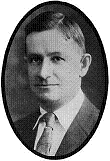
Washington & Jefferson had been a football power for years, climaxing in 1921
with a 10-0-1 finish, a tie with 9-0-1 Cal in the Rose bowl, and MNC
contention. Hall of Famer Andy Kerr (pictured) was the coach by this
time, and he started great, 7-1-1 in 1926 and 7-0-2 this season, but he
fell to 2-5-2 in 1928, and 1927 is the last season Washington &
Jefferson ever fielded a top 25 team. Kerr moved on to Colgate, where
he had another strong start, including a 9-0 finish in 1932. Overall he
was 137-71-14 for his career.
Washington & Jefferson's best player was tackle Forrest "Jap"
Douds, a nonconsensus All American in 1928 and 1929. He played pro ball
for 5 years, and was an all-pro in 1930.
Washington, California, and St. Mary's
Next we've got
some West Coast teams, 9-2 Washington, 7-3 California, and 7-2-1 St.
Mary's (California). Washington would have been rated at about this
spot by an AP poll anyway, but Cal and St. Mary's are moving up a bit
from where an AP poll would have placed them. Cal's 3 losses came to #6
Southern Cal, #11 Stanford, and Washington, the last 2 by just a
touchdown. They defeated 5-4-2 Santa Clara, 7-2-1 St. Mary's, a strong
Olympic Athletic Club, and 6-4 Penn. St. Mary's lost to Cal and the
Olympic Club, and they took an upset tie at unrated 4-1-3 Idaho, but
they beat #11 Stanford 16-0 and 5-4-2 Santa Clara (who also beat
Stanford) 22-0.
I'm thinking 10-0 Centenary would have been
rated behind Washington and ahead of Cal and St. Mary's, and while I
think Centenary could viably
be rated higher than Cal and St. Mary's, that would depend on their
opponents also being rated more highly than they would be by an AP
poll, and on Centenary being rated higher than Stanford (or at least
Washington). As it is, there isn't good reason to rate Centenary
higher. Their schedule was mostly made up of minor teams, their only
tough games were at home, and they barely beat a bad Baylor team. With
Stanford (and Washington) rated higher than Centenary, St. Mary's has a
better relevant record than Centenary does because St. Mary's beat
Stanford. And it is quite possible that an AP poll would have rated Cal
and St. Mary's higher anyway.
Washington #16, California #17, and St. Mary's #18. St. Mary's had
their first consensus All American this season, center Larry
Bettencourt (also a Hall of Famer). He blocked punts in 6 consecutive
games this season.
Centenary, Southern Methodist, and Nebraska
Next up are 10-0
Centenary, 7-2 Southern Methodist, and 6-2 Nebraska. Nebraska probably
would have been rated higher than SMU in an AP poll, as they had
attention-getting wins over 5-3-2 Syracuse and 7-1-2 NYU, but Nebraska
took an upset loss and SMU didn't. More importantly, the team that
upset Nebraska, 7-2 Missouri, lost 32-9 at SMU. SMU's losses came to #7
Texas A&M and Centenary.
Strange to see Centenary all the way down here at #19 when I think they are very close to meriting a share of the 1927 national championship
(details on the team in that article), but this is about where an AP
poll would have placed them, and it is logically viable, so this is
where they end up. I would personally rate Centenary and SMU in the top
10.
Centenary #19, Southern Methodist #20, and Nebraska #21.
Tennessee, Vanderbilt, and Texas
Coming in next are 8-0-1 Tennessee, 8-1-2 Vanderbilt, and 6-2-1 Texas.
It may seem strange looking back from today that an AP poll would have
so dismissed an 8-0-1 Tennessee team, but at this time Tennessee was a
nobody. Centenary had more national name value because they had
recently been coached by a nationally famous figure (Bo McMillin, the
celebrated consensus All American from Centre's 1919-1921
teams). And Tennessee played no one of value this season except
Vanderbilt, whom they tied at home, while Centenary defeated 7-2 SMU.
But Tennessee was coached by Hall of Famer Robert Neyland, who was
early in the process of putting the Volunteers on the football map. He
would retire 25 years later as one of the greatest college football
coaches of all time.
Vanderbilt's "upset" loss to Texas keeps
them behind Tennessee. I wouldn't call it an upset myself, and would
rank Texas higher, but Vanderbilt's ties with #8 Georgia Tech and 8-0-1
Tennessee, combined with Texas' upset tie to unranked Texas Christian,
gives reason for Vanderbilt to be ranked higher, and a 1927 AP poll
would surely have done so. Texas probably wouldn't have made an AP
poll's top 25 in 1927 at all, but with a win over Vanderbilt, who would
have been ranked, Texas has no logical contenders for spot #24. Their 2
losses came to #7 Texas A&M and #20 SMU.
Tennessee #22, Vanderbilt #23, and Texas #24.
#25: Georgetown, Navy, NYU, Missouri, or Arkansas?
Our contenders for the last slot are 8-1 Georgetown, 7-1-2 New York, 6-3 Navy, 7-2 Missouri, and 8-1 Arkansas.
I think 8-1 Georgetown might have been ranked as high as #20 in an
AP poll, but they beat no one and took a loss to unrated 5-3-2
Syracuse, so I'm tossing them out of contention. They did roll up some
very impressive scores, though. 7-1-2 NYU likely would have been ranked
as well, but they took a pair of ties against unrated teams, 6-2-1 Penn
State and 4-2-3 Colgate, and they should probably be ranked behind PSU.
And PSU belongs behind Bucknell, who belongs behind Temple, who will
not quite make this top 25. Like Georgetown, NYU rolled up big scores
but beat no one. They're out too.
6-3 Navy and 7-2 Missouri both
would have had a shot at making the bottom of a 1927 AP top 25, and
it's hard to say which would have been rated higher. Navy was the defending national champion,
and they fought #2 Army to a tough 14-9 loss in their finale, which
would have given them a solid chance at passing Missouri because Mizzou
was upset by 3-4-1 Kansas in their penultimate game. But Missouri had
beaten #21 Nebraska, a better win than any by Navy, they gained
attention with a pair of intersectional wins (over Northwestern, whom
#9 Illinois barely beat, and West Virginia, who tied #15 Washington
& Jefferson), they were a conference champion, and they had a
better straight record than did Navy. They also beat 4-3-1 Iowa State,
who tied #9 Illinois. So I'm giving Missouri the edge here over Navy,
who therefore ends up #26.
Arkansas' 8-1 record looked great,
but they would have had little to no chance of being rated higher than
Missouri or Navy because no one paid any attention to them. Their
schedule was very weak. Still, I think Arkansas probably was one of the
25 best teams in the country this season, and it's too bad their
schedule did not afford them the opportunity to show it.
Missouri #25.
Missouri
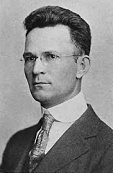
Missouri
rose up to finally give Nebraska a brief challenge in the Missouri
Valley in the mid-1920s. Gwinn Henry (pictured) was the coach. He had
gone a blistering 37-3 at Emporia 1918-1922, and Missouri hired him to
do the same for them. It didn't quite work out, as he was just 40-28-9
at Missouri 1923-1931, but he had a terrific run 1924-1927 in which
Missouri went 25-6-3 and won 3 conference titles. Overall he was
61-53-10 at 5 schools.
Others
Receiving Votes
Here
are the teams closest to making this top 25. Because I think 7-1-2 NYU
should be rated behind Penn State, who should be behind Bucknell, who
should be behind Temple, NYU does not make this list (but they'll be
#11 for 1928).
Navy 6-3
Navy's losses
came to #3 Notre Dame, #10 Michigan, and #2 Army in a close 14-9
decision in their finale. As such, they might well have been a #11-25
team, but their only win of value was 12-6 at 6-4 Penn.
Arkansas 8-1
Arkansas lost
only to #7 Texas A&M, but by a huge score (40-6). They beat 4-3-2
Texas Christian, who is on this list, 10-3 on the road, but they turned
in an ill performance in a 13-6 home win over 2-7 Baylor.
Temple 7-1
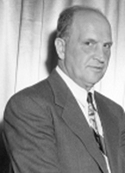
Temple's
loss was dealt 47-7 at #13 Dartmouth. They put up some huge scores,
most notably 110 points against patsy Blue Ridge, and they beat a
pretty good 6-3-1 Bucknell 19-13, but their schedule was largely
garbage, and they struggled to get by 3-6-1 Brown 7-0.
Temple
had never been a football power, and they never would be, but at this
time they had visions of becoming one. The coach was Henry Miller
(pictured), who had been a consensus All American end for Penn in 1919.
He went 50-15-8 at Temple 1925-1932, and this season's success led to
the construction of Temple Stadium for the next season. But Miller
wasn't quite getting Temple up to the level of success they wanted, so
in 1933 they shelled out the big bucks to replace him with Pop Warner.
Warner didn't really do much better, going 31-18-2 over 6 years, but he
did get them to #23 in my hypothetical AP poll rankings for 1934. They were 7-1-2 that season and played in the Sugar Bowl. Temple's football history has otherwise been mostly a barren desert.
Georgetown 8-1
Georgetown
probably doesn't belong on this list, as their schedule was weak and
they lost 19-6 to unrated 5-3-2 Syracuse. But they were very impressive
otherwise, outscoring opponents 377-21 even with that loss, an average
score of 42-2. Their best wins came 25-0 over 2-4-3 West Virginia (who
tied #15 Washington & Jefferson) and 27-2 over 5-3-1 Lafayette (who
tied West Virginia). They'll be #10 for 1928, so maybe they were top 25 this season and just had one bad outing in the Syracuse game.
Texas Christian 4-3-2
Texas Christian
was much better than their straight record would seem to indicate.
Their losses came to #19 Centenary, #20 SMU, and 8-1 Arkansas. They
tied #7 Texas A&M and #24 Texas. They would definitely make my own
top 25. They did, however, put up a weak result in a 20-13 home win
over Austin, and their other wins were unimpressive as well.
Furman 10-1
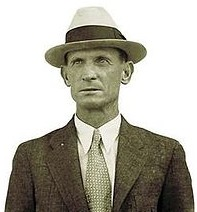
Here's
another team that might have been top 25 quality for all we know,
though it's doubtful. Furman's one loss came to #5 Georgia, but it was
ugly, 32-0. They beat 9-1 North Carolina State 20-0, but as covered
next, NC State beat no one. Furman looked weak in a 6-0 win at the
Citadel (3-6-1) and a 13-7 decision at Duke (4-5). Duke lost to Navy,
who ended up #26, by a much more impressive 32-6.
Furman has
never fielded a top 25 team, this being their closest call. Their coach
was Billy Lavall, who went 84-38-4 at Furman 1915-1927. South Carolina
hired him away, and he was not quite as successful there, but he did
post a winning season in each of his 7 years in Columbia. Overall, he
was 172-139-17 at 4 schools and over a long 34 season career, and he is
in the South Carolina Athletic Hall of Fame.
North Carolina State 9-1
As stated, North
Carolina State lost 20-0 to 10-1 Furman, and they didn't beat anyone of
any real value. They won 20-18 at 4-5 Duke and 12-6 at 7-3 Florida
(Florida lost to 4-4-1 Davidson). They probably don't belong on this
list, but 9-1 looks good, and we don't see much of NC State back in
these days, so I included them.
Detroit 7-2
Detroit's
losses were doled out by #2 Army and #3 Notre Dame, and they only lost
to Army by 6 points on the road, so here is yet another team that might
well have been top 25 quality. But they did nothing in the rest of
their schedule, the best result being a 12-7 win at 5-4-1 Carnegie, so
who can really know? They would go 9-0 and are ranked #9 for 1928,
so I do think they were likely a top 25 team this season as well. But a
1927 AP poll would certainly not have ranked them, and there's good
reason for that due to their schedule, so here they sit on the outside
looking in.
1927
Top 25
1)
Yale 7-1
2) Army 9-1
3) Notre Dame 7-1-1
4) Minnesota 6-0-2
5) Georgia 9-1
6) Southern Cal 8-1-1
7) Texas A&M 8-0-1
8) Georgia Tech 8-1-1
9) Illinois 7-0-1
10) Michigan 6-2
11) Stanford 8-2-1
12) Pittsburgh 8-1-1
13) Princeton 6-1
Dartmouth 7-1
15) Washington & Jefferson 7-0-2
16) Washington 9-2
17) California 7-3
18) St. Mary's (California) 7-2-1
19) Centenary 10-0
20) Southern Methodist 7-2
21) Nebraska 6-2
22) Tennessee 8-0-1
23) Vanderbilt 8-1-2
24) Texas 6-2-1
25) Missouri 7-2
Others
Receiving Votes:
Navy 6-3
Arkansas 8-1
Temple 7-1
Georgetown 8-1
Texas Christian 4-3-2
Furman 10-1
North Carolina State 9-1
Detroit 7-2






